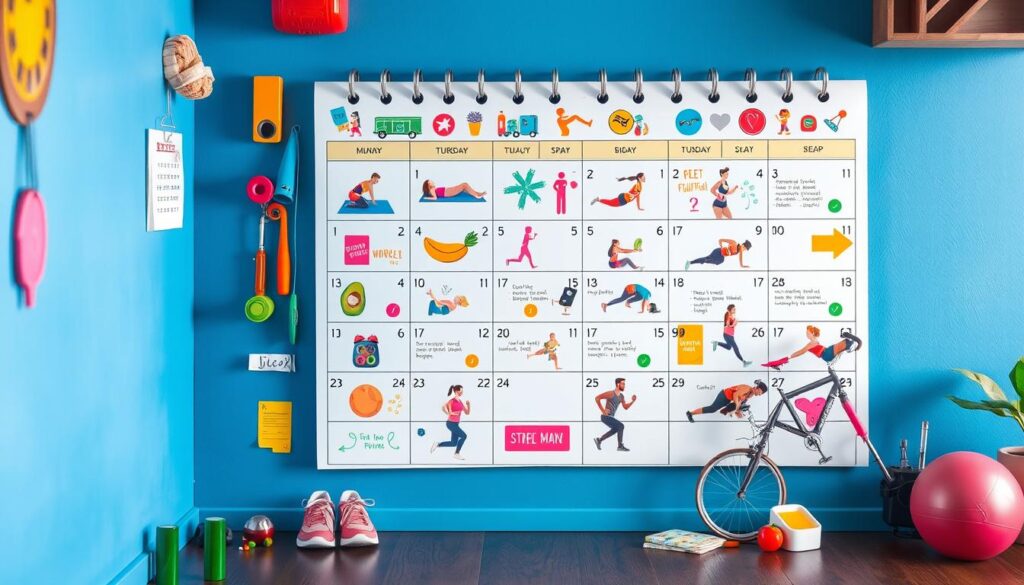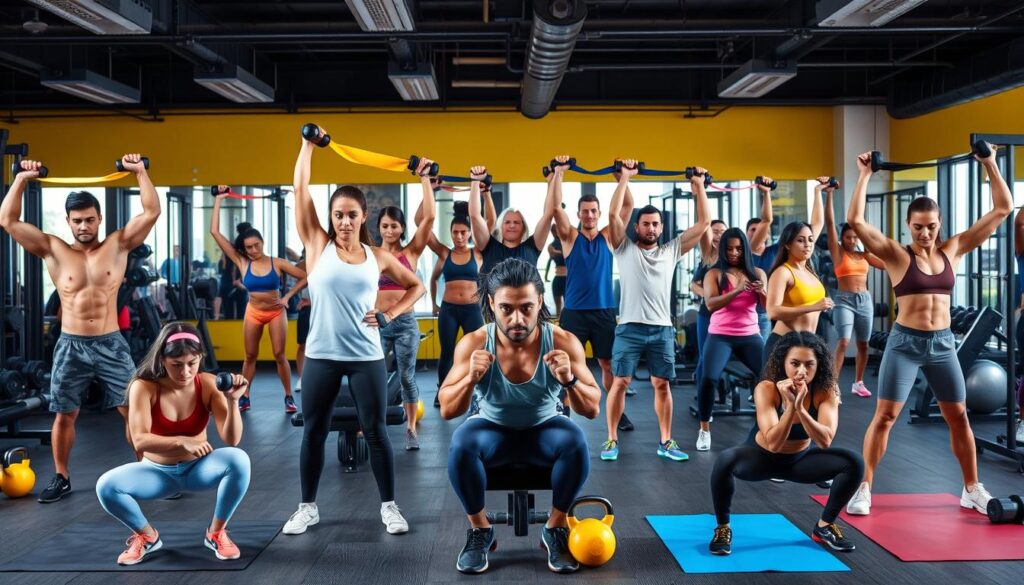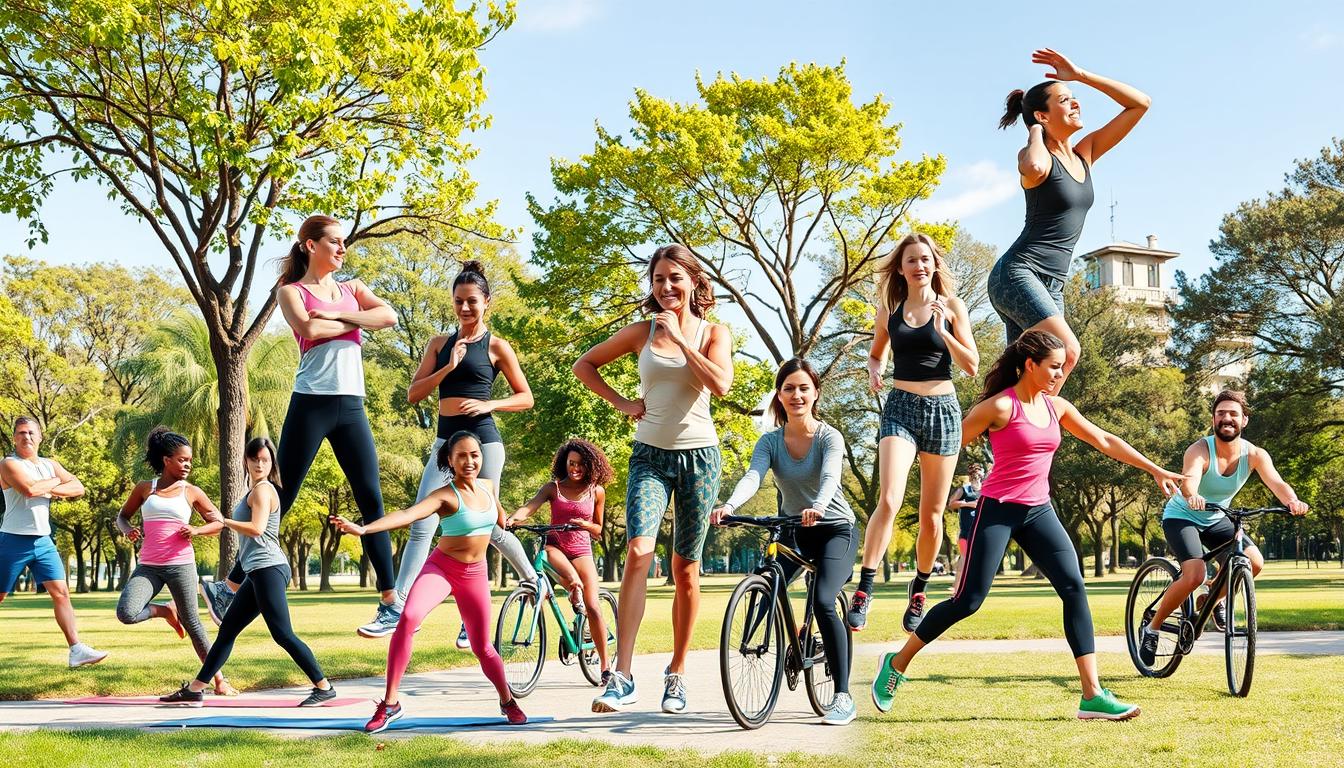Start a 30-day fitness journey to make your own exercise plan. The Women’s Health 30-Day Workout Challenge has a customizable routine. It includes strength and cross-training options.
Expect to see more muscle definition, more energy, and better fitness. NIH studies show daily exercise for 4-5 weeks can make habits last. You can choose bodyweight or dumbbell workouts, focusing on form and technique.
Key Takeaways
- 30-day fitness challenge emphasizes consistency and habit formation
- Daily workouts take only 20 minutes, using bodyweight or light dumbbells
- Personalized plan includes strength training, cross-training, and recovery days
- Expert-designed program helps build muscle, boost metabolism, and improve fitness
- Accessible workout videos and 60-day free trial of Women’s Health+ membership
Understanding the Fundamentals of a 30-Day Fitness Journey
Starting a 30-day fitness plan is exciting and can change your life. You’ll see real improvements in your health, like stronger muscles and more energy. Success comes from setting achievable goals and having the right tools for your workout plan.
Benefits of Committing to a Month-Long Program
A 30-day fitness journey brings many benefits for your health and lifestyle. It’s long enough to form new habits but not too long to feel overwhelming. You’ll see better heart health, stronger muscles, and might even lose weight or change your body shape.
Setting Realistic Fitness Goals
When starting a new fitness regimen, setting realistic goals is key. These goals should match your current fitness level and what you want to achieve. Break down big goals into smaller, achievable steps to stay motivated and track your progress.
Essential Equipment for Getting Started
To start a successful workout schedule, you need the right gear. This could be resistance bands, exercise balls, yoga mats, and dumbbells. Beginners should start with light weights (3-5 pounds for women, 5-8 pounds for men) and focus on proper form before increasing the weight.
“Consistency is key when it comes to a 30-day fitness journey. By establishing a routine and sticking to it, you’ll be well on your way to achieving your goals.”
Building Your Perfect Exercise Routine
Creating the perfect exercise plan is key to reaching your fitness goals. Whether you want to lose weight, build muscle, or boost your health, a good workout routine is crucial. It’s important to mix cardio, strength training, and flexibility exercises.
Cardio activities like walking, jogging, cycling, or swimming help burn calories and improve heart health. The U.S. Department of Health and Human Services suggests 150 minutes of moderate aerobic exercise weekly or 75 minutes of vigorous activity.
Strength training targets specific muscles, helping build lean muscle and increase metabolism. Adults should do two or more strength training sessions weekly, with at least 48 hours of rest in between. Focus on exercises that work many muscles at once for better results.
Don’t forget to include flexibility and mobility exercises like yoga, Pilates, and tai chi. These improve balance, stability, and range of motion, which is vital for older adults to prevent falls.
By following this balanced approach in your exercise plan, you’ll be on your way to reaching your fitness goals. Enjoy the benefits of a healthy, active lifestyle.
| Workout Type | Recommended Duration | Frequency |
|---|---|---|
| Cardiovascular | 150 minutes of moderate or 75 minutes of vigorous activity | Weekly |
| Strength Training | 8-12 reps per exercise | 2-3 sessions per week with at least 48 hours of rest between |
| Flexibility and Mobility | Varies based on activity | Daily or as needed |

Consistency and gradual progress are the secrets to a successful workout routine. Begin with a plan that’s realistic and achievable. As you get better, adjust it to keep growing and improving.
Establishing a Strong Foundation with Core and Mobility Work
Building a solid foundation is key for any good exercise plan. Focus on core strengthening and mobility exercises. This will help you create a strong, resilient body that supports your fitness journey.
Key Mobility Exercises for Better Movement
Improving your mobility is vital for better movement and flexibility. Aim for three to five days of mobility work each week. Try exercises like the Spiderman Lunge to T-Spine and Squat to T-Spine for better movement.
Core Strengthening Fundamentals
A strong core is the base for all exercises. Include exercises like Hollow Rocks and Plank Shoulder-Taps in your routine. Do 12-15 reps of each, focusing on proper form and breathing.
Proper Form and Technique Guidelines
Good form and technique are crucial, no matter the exercise. They help you get the most out of your workouts and prevent injuries. Always check your alignment, movement, and breathing.
By focusing on core and mobility, you’re setting up for a great 30-day fitness journey. Sticking to these basics will improve your movement, strength, and injury prevention.
| Exercise | Description | Benefits |
|---|---|---|
| Spiderman Lunge to T-Spine | Start in a high plank position. Bring one knee towards the same elbow, then rotate your torso to open up the chest. | Improves hip and thoracic spine mobility. |
| Squat to T-Spine | Stand with feet shoulder-width apart. Perform a squat, then rotate your torso to one side as you rise back up. | Enhances mobility in the hips, spine, and shoulders. |
| Glute Bridge Reach | Lie on your back with knees bent and feet flat on the floor. Lift your hips up, then extend one arm overhead. | Improves hip and thoracic spine mobility. |
“Consistency and regular practice of mobility exercises are crucial for seeing improvements in range of motion, flexibility, and joint health.”
Strength Training Components for Total Body Transformation
For a total body transformation, a complete strength training program is key. Exercises that target all major muscle groups help build lean muscle and boost metabolism. Start with basic movements like pushups, squats, rows, and hip hinges to build a strong foundation.
Begin with one set of 15 reps for each exercise. As you get stronger, do more sets. Always focus on the right form to get the most benefits and avoid injuries. Increase the weight or resistance as you get stronger to keep challenging your muscles.
| Exercise | Target Muscle Groups |
|---|---|
| Pushups | Chest, Shoulders, Triceps |
| Close-Grip Pushups | Triceps |
| Bent-Over T Raises | Back, Shoulders |
| Paused Squats | Quadriceps, Glutes |
| Single-Leg Glute Bridges | Glutes, Hamstrings |
Adding these exercises to your routine will shape and tone your body. This leads to a more defined and muscular look. Don’t forget to rest and recover well between workouts to help your muscles grow and improve your fitness.

Cardio Integration and Cross-Training Strategies
To boost your fitness, mix cardio workouts with cross-training. Try different cardio activities and adjust the intensity. This way, you get the most benefits and let your body recover.
Effective Cardio Workout Options
Try various cardio exercises like treadmill runs, elliptical sessions, and stationary bike workouts. They work different muscles and keep you engaged. Interval training, with high-intensity bursts followed by rest, also boosts your heart health.
Balancing Intensity Levels
Finding the right intensity in cardio is key. Use the perceived exertion (PE) scale to check how hard you’re working. Aim for a 4 to 7, to challenge yourself without overdoing it.
Recovery Between Sessions
Active recovery is important. Try swimming, cycling, or low-impact strength training between cardio sessions. It prevents burnout, reduces injury risk, and keeps you moving forward.
| Cardio Workout | Intensity Level | Recovery Activity |
|---|---|---|
| Treadmill Run | 6-7 (Challenging) | Stationary Bike |
| Elliptical Workout | 5-6 (Moderate) | Swimming |
| Rowing Machine | 6-7 (Challenging) | Bodyweight Strength Training |
“Integrating cardio and cross-training is a powerful strategy for building a well-rounded fitness foundation. The key is finding the right balance to challenge your body while allowing for proper recovery and adaptation.”
Progressive Overload and Workout Advancement
To reach your fitness goals, you need more than just a routine. You need a plan that pushes your body to grow. This plan is called progressive overload, where you make your workouts harder over time.
Using progressive overload is key to getting better in your exercise timetable and workout progression. By making your muscles work harder, you can see big improvements in your fitness.
- Start with 30-minute workouts and slowly increase the time to 60 minutes or more. This helps your body get stronger.
- Every week, add a little more weight or resistance. Try to increase it by no more than 10%. This keeps your muscles challenged without hurting you.
- Try more complex exercises like jumping or compound lifts. This keeps your body on its toes and helps it grow more.
To keep things interesting and avoid getting stuck, try different workout styles. Try AMRAP, EMOM, and EMOM+1. These styles will help you reach new heights.
| Week | Bench Press (lbs) | Workout Duration (min) | Intervals |
|---|---|---|---|
| 1 | 100 | 30 | 8 |
| 4 | 105 | 45 | 10 |
| 8 | 110 | 60 | 12 |
Remember, getting better takes time and patience. Celebrate your small wins and keep up with your exercise timetable and workout progression. With progressive overload, you’ll see big gains in strength, endurance, and fitness advancement.
“The secret of change is to focus all of your energy, not on fighting the old, but on building the new.” – Socrates

Tracking Progress and Measuring Success
Staying motivated and on track during your 30-day fitness journey is key. Keeping a fitness tracking routine and workout journal helps you monitor your progress measurement. This way, you can adjust your program as needed.
Recording Workout Data
Consistency is crucial for fitness tracking. Record important details about your workouts. This includes the exercises, weights, reps, and how hard you felt it was. This data shows where you’re improving and your strength gains.
Body Measurements and Milestones
The scale is just one tool. Take regular body measurements too. This includes your chest, arms, waist, and hips. Celebrate your achievements, like a new personal best or fitting into a smaller size. These victories boost your motivation and confidence.
Adjusting Your Program Based on Results
Use your workout journal data to adjust your routine. If results aren’t what you hoped for, look at your program. Make changes to your training, nutrition, or recovery. Stay open to trying new things to find what works for you.
“Consistent tracking and measurement are essential for achieving your fitness goals. Without a clear understanding of your progress, it’s impossible to make the necessary adjustments to your program.”
By tracking your fitness tracking, progress measurement, and workout journal data, you’ll celebrate your wins. You’ll also know where to improve. This keeps you on the path to a healthier, more confident you.
Creating Sustainable Exercise Habits Beyond 30 Days
As you near the end of your 30-day fitness challenge, the real test begins. You need to turn your enthusiasm into a lasting exercise blueprint that’s part of your lifestyle. The first 30 days were just the start. Now, it’s time to build habits that last.
To keep going, mix up your workouts. Try new exercises and training methods to stay excited and see progress. Also, set new, achievable goals often. This will keep you motivated and focused on your fitness journey.
Make your exercise routine fit your lifestyle. Think about your schedule, likes, and who you hang out with. This way, you can make exercise a regular part of your life. Consistency is key for lasting results and better health.















Hairstyles VIP
Attractive section of content. I just stumbled upon your site and in accession capital to assert that I acquire actually enjoyed account your blog posts. Anyway I抣l be subscribing to your augment and even I achievement you access consistently fast.